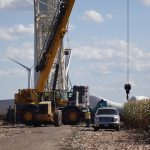Logistics costs account for 10-15 percent of the total turbine cost. Understanding and controlling these costs is an important part of managing the overall budget. An area of costs not typically budgeted, but which may contribute significantly to the overall logistics costs, are demurrage and detention fees. Under certain circumstances these charges may increase the logistics costs by 20 percent or more.
What Are They?
Demurrage and detention fees are penalty charges that owners apply when assets such as vessels, rail cars, containers, or truck transportation equipment sit idle through no fault of the asset provider. The purpose of the charges is to encourage the consignee to load and unload quickly. It is standard practice for the asset owner to provide a set amount of “free time” for loading and unloading, but once the allotted time expires demurrage and/or detention fees apply.
The more expensive the asset, the higher the fee charged. For example, demurrage for project cargo vessels can range in cost from between $15,000-$22,000 per vessel per day. Rail demurrage and detention costs will vary by equipment type. Charges typically escalate by the number of days per car type. Charges are fixed by the published rail tariff. Detention for heavy haul truck equipment varies from $1,500-$5,000 per truck per day, depending on the asset type. The actual detention charges are subject to negotiation.
Why Do They Occur?
Demurrage and detention charges usually occur when planning schedules are out of balance. Transloading wind components require the right type and amount of cranes, labor, fixtures, bracing materials, and transportation equipment. Delays will result if any one of these items is not available in sufficient supply. A lack of proper paperwork or state-induced permit restrictions can also lead to costly delays. Some delays are a result of poor weather conditions, such as high winds or lightning storms, and cannot be controlled. Nonetheless, the consequences of the event will still need to be managed. Finally, if a wind farm site is not ready to receive components due to delays in road construction, lack of proper lift equipment, or site preparation, trucks will remain idle at the site waiting to be offloaded. Not only will detention charges apply, but the equipment is unavailable to move other components.
How Can They Be Mitigated?
When components are transported en masse, in trains or in vessels, it may be critical to obtain suitable land to pre- or post-stage components. Ideally, it is best to transfer components directly from one transportation mode to the next (vessel to rail), but in many cases this situation is not possible. If not enough crane equipment, labor, or transport equipment is available to balance the transfer of components directly, equipment will sit idle and detention and demurrage charges become a much greater risk.
Attention to detail and paperwork is important to avoiding unnecessary delays. Component measurements and specifications need to be exact and documentation filed correctly and approved in advance. Managers should understand and plan for specified transportation rules for large components including the potential need for pilot cars, police escorts, and restrictions on hours of travel. For rail transport, managers need to ensure that cars are ordered correctly and, if applicable, ordered in the correct sequence. When cars are unloaded they need to be released as quickly as possible.
Clearly defining and assigning responsibility for “shipment-ready” conditions for each component will reduce unforeseen delays with shipments. Fixtures and bracing requirements vary by component and shipment mode. Deciding in advance who is responsible for shipment-ready conditions (the component manufacturer, the buyer, or the logistics service provider) reduces confusion and ensures that materials are ready when the transportation equipment arrives.
On-site logistics management at loading and unloading points is an important link in managing the fluid and multivariable conditions that can lead to delays. If weather issues arise, or if the next link in the supply chain is not prepared as planned, on-site managers can make tactical and executional adjustments to the schedule to get back to plan as quickly as possible. The presence of on-site management facilitates communication, clarifies project details, and improves the quality and speed of decision making.
Fees caused by unexpected logistics delays can contribute substantially to the overall logistics budget. While not all delays can be anticipated or controlled, applying a few important project management techniques will reduce the risk of detention and demurrage costs getting out of control.


































